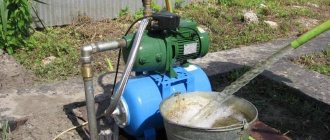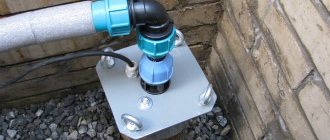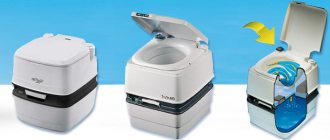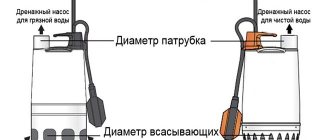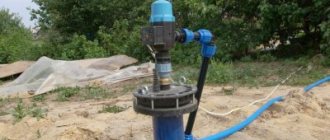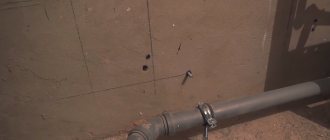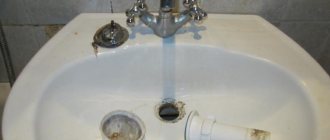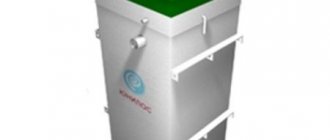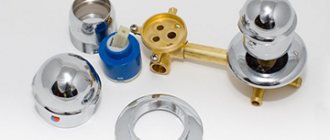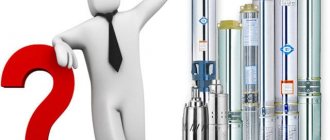To ensure proper operation of the well, it is necessary to have a suitable sample pumping station. To choose equipment wisely, you should take into account all the factors and features of the devices. The modern market offers a wide range of models with different price categories and functionality.
We invite you to familiarize yourself with the features of pumps for wells, which will help you make the right choice.
Main characteristics of wells
When choosing a pumping station, you should consider the following well parameters:
- Static level
- Dynamic level
- Debit
- Bottom level
- Pipe diameter size
If the well owner has a technical document, then it contains all the necessary information on these criteria. If the well has not been in use for a long time, it is necessary to measure the parameters yourself.
Submersible and surface pumps, their differences
There are two main types of pumps - surface and submersible installation.
There are two main types of pumps - surface and submersible installation. Installation of surface devices is carried out at ground level next to the water source. Submersible units are placed directly in the aquatic environment.
In what cases should you choose a surface-type pump for a well?
A surface well pump is suitable when the maximum depth of the water source is 10 m.
Expert opinion
Kuznetsov Vasily Stepanovich
Surface pumps of different models have different types of structure. The most popular is the centrifugal pump. This device is suitable for servicing wells and shallow wells.
The peculiarity of the operation of a pump of this type is to pump liquid under the influence of centrifugal pressure, when water moves to its walls and is pushed out through the nozzle with pressure. The main element of pumps of this type is a wheel, on the surface of which blades with wings are placed.
The correct choice of pumping equipment ensures uninterrupted operation of the device and guarantees its wear resistance.
Features to consider:
- Maximum water rise level (pressure level)
- Distance of water transportation through the pipeline
- The amount of water that needs to be transferred in a certain time (performance)
Surface water pumps: types, design features, rules for selection and commissioning
The surface pump is designed to supply technical and drinking water to the irrigation and water supply systems of a country house. Liquid can be taken from wells, storage tanks, wells, etc. Pumps are designed to supply water.
What are surface pumps?
Surface pumping devices are compact and inexpensive installations. The main difference between such equipment is that the devices are installed at a short distance from the underground source.
The materials used to make the housing are stainless steel, cast iron or polymers. The latter option is preferable, since composite models are lightweight, have good wear resistance and are not susceptible to corrosion.
The standard power of the device allows you to draw water from sources located at a depth of no more than 10 meters. To improve the technical capabilities of the unit, submersible injectors are connected to the supply system, allowing to increase the pressure force and lift the liquid to a height of up to 30 meters.
The principle of operation of the pumping equipment is that the installation itself is located on the surface, and an intake hose equipped with a check valve is lowered into the well. The liquid enters the chamber of the device, from where it is pumped to the consumer using blades and a pressure pipeline.
For some models, water rise is allowed only if the intake pipe and pump chamber are first filled. Such devices are called devices with normal suction.
Among the main areas of application are the following:
- independent water supply for a country house;
- garden plot irrigation;
- drainage of basements;
- increase in pressure in the system.
The units are supplied complete with pumping stations, the structure of which contains elements of a control and monitoring system designed to automatically turn the device on and off.
Selecting a unit taking into account well parameters and required pressure
One of the main factors to consider when choosing a surface equipment model is the diameter of the well.
If the water supply source is not yet ready, the owner can get advice from specialists who will drill it. When choosing equipment, it is worth taking into account the quality of water and the presence of solids in its composition. Such inclusions can only be pumped with a pump equipped with a coarse filter. This factor will significantly reduce the risk of equipment malfunctions and malfunctions.
Expert opinion
Kuznetsov Vasily Stepanovich
If the built-in filter is not included in the package, then it must be installed.
Another factor to consider when choosing a surface unit for a well is the maximum fluid pressure that the pump can handle. This value is measured in bars and is indicated in the technical document.
To determine the required maximum pressure, add the number 30 to the well depth, and then add another 10%.
Important parameters
When choosing a pump to service an underground well, you should first of all focus on the depth from which the liquid must be pumped out. To determine this parameter, you need to lower a dry rope with a weight at the end into a pre-drilled well, with the help of which you can find out at what depth the water is located in the underground source.
Selection of a pump begins with determining the depth of the well and the distance of water pressure supply
Having determined the depth of the water, you can begin to select pumping equipment that should ensure its rise to the surface and further transportation through the pipeline system. The maximum depth from which a surface pump of a certain model is capable of lifting water is indicated in the technical data sheet for such a device. It is better to select a surface pump model for a well with some reserve in terms of the created pressure of the pumped liquid medium. This approach to the selection of pumping equipment will ensure its operation without overloads, which may periodically occur during the operation of such devices.
If we talk about the most important parameters that people usually pay attention to when choosing surface pumps for a well, these include:
- the maximum height to which the pump can lift water (this indicator characterizes such a parameter as the created pressure, measured in meters of water column);
- the distance over which it is necessary to transport water through the pipeline served by the pump;
- the volume of water that the pump must pump per unit of time (this indicator is characterized by such a parameter as productivity, usually measured in liters per minute or per hour).
For a complete water supply to a family of 3–4 people, you need a pump with a capacity of 3–5 m3/hour, but if you plan to use the pump periodically, then 1–2 m3/hour is enough
In order to make it clear how to choose a surface pump based on the above parameters, we can consider this procedure using a specific example. Let’s say an external pump is selected for a well whose depth is 10 meters, and such a well is located 15 meters from the house. The performance with which the selected pump must pump water from the well is 60 liters per hour. Based on these initial parameters of the surface pump, you should purchase equipment that is capable of pumping water with the required productivity from a well, the depth of which is at least 12 meters. By choosing pumping equipment with such a reserve in terms of the pressure it creates, you are guaranteed to be able to ensure its operation in the most comfortable mode for it.
Additional devices that are necessary for the correct functioning of the device
To ensure uninterrupted operation of a surface pump for pumping water from a well, additional technical devices are required. For example, if the water contains a lot of sand or other elements, it is worth installing a reliable purification system. The filter will protect the internal parts of the device from various damages and increase the level of wear resistance.
Additional devices may be required for the device to function correctly.
Required additional items:
- A bendable hose or metal pipe through which water will pass to the surface
- Automatic electricity system with which the device will be connected to the electricity network
- A check valve that prevents water from returning back into the well
Choosing the optimal pump for a well
After reading this material, you can get answers to these questions, and if you want to buy high-quality borehole pumps, you can do this in our Volmax online store or in the engineering centers of the same name, which are open in Kolomna, Stupino and Orekhovo-Zuevo.
Content:
• Features of the well • Quality of the well and the influence of this indicator on the selection of equipment • Hoses and casing for wells • Surface or submersible pump for a well • Vibrating and centrifugal submersible pumps for wells
Well features
To select the right pump for a well, it is necessary to take into account its features, in particular:
• flow rate (this is the productivity of the well); • static and dynamic level; • mark of the base of the bottom; • depth; • diameter (internal) of the casing pipe.
Typically, standard wells for water supply are made from 8 to 35 meters deep, and artesian wells - from 50 to 150 meters. If such services are provided by a specialized organization, then it issues documents containing all the necessary information. However, in some cases the necessary papers are not available, then you can obtain most of the important data yourself.
To choose the right pump for a well, you need to measure its depth. This can be done with a cord with a weight, which is lowered into an empty well where there is no equipment for supplying water. The static level of the well is also measured using a cord and weight. This procedure is performed after the pump is removed from the well, and it has settled after water intake (at least one hour). The static level is the distance from the ground to the water in the well, so the cord with the load must be lowered until a splashing noise is heard.
The dynamic level is also the distance from the ground to the surface of the water, but only after water has been drawn from the well for a long time by a powerful pump. When it becomes clear that almost all the water from the well has been pumped out and it is not going down, then measurements are taken using a cord and a weight, which are lowered down until there is a splash.
Comparison of dynamic and static levels gives an indirect idea of the productivity of the well, which must be taken into account when selecting a well pump. It is believed that the smaller the difference between these indicators, the more productive the well. In some cases, the static and dynamic levels are almost equal, which means: water arrives at the well so quickly that it immediately makes up for losses from water intake. If the difference does not exceed one meter, the well is considered highly productive.
Do not forget that the dynamic level indicator is also important when installing a submersible pump, which is usually located at a distance deeper than 2 meters from the dynamic level, which will allow the equipment to always be in water.
Well flow rate is the volume of water that can be pumped out of a well in a certain period of time.
Typically this indicator is measured l/min, cubic meters. m/hour and it varies depending on the time of year, pump power and other factors. An approximate formula for calculating flow rate:
Well flow rate = H x V/ (Hd – Hst), where:
• well depth, m – H; • well flow rate, m3/h – D; • pump capacity, m3/h – V; • dynamic level, m - Hd; • static level — Hst.
The flow rate indicator is important, since when installing a powerful and productive pump in a low-flow well, it can be drained, which can lead to a stop in the water supply and breakdown of the main equipment.
The internal diameter of the well casing is important for the correct selection of a submersible pump that will be lowered into the well. This indicator can be measured with a regular ruler, which is applied to the pipe. Most manufacturers recommend selecting equipment based on the fact that the diameter of the pump should be 3 cm smaller than the internal diameter of the casing.
Well quality and the influence of this indicator on equipment selection
Not only the reliability and trouble-free operation of the well, but also the operation of the pumping equipment depends on the professionalism of the drillers.
If a well is made according to all standards, then it will silt up much less often, which makes it possible to buy and use conventional pumps. If the well is made by amateurs, then the likelihood of it silting is high, so it is necessary to purchase submersible deep well pumps that can operate in contaminated water. Well cleaning specialists recommend periodically diagnosing wells, without waiting for the moment when the entire water supply system begins to work intermittently. The fact that the well is silted is indirectly indicated by the depth of the pump in relation to the water surface. For example, if the pump is raised 0.5-1.5 meters and it appears above the surface of the water, then this indicates contamination of the well. As a rule, it is recommended to clean wells once every 5-10 years. The difference in timing depends on the quality of the well itself and its parameters, terrain features, intensity of use and some other factors.
Hoses and casing for wells
If previously there was no particular alternative to rubber hoses, now it is much more profitable and reliable to use plastic pipes of the required diameter. Rubber hoses begin to deteriorate over time, and often during operation the walls of the hose become compressed, which worsens the pressure and can lead to equipment breakdowns. Plastic pipes do not have these disadvantages.
Many experts recommend using casing pipes with a diameter of at least 4 inches (about 10.1 cm) for household filter wells, which simplifies the selection of pumping equipment. For example, the Vodomet series from Gilex is designed to supply water from wells with an internal diameter of more than 10 cm. However, some manufacturers offer high-quality deep-well pumps for narrower wells. For example, models of the Grundfos SQ/SQE series with a 3-inch body can be used in wells with a diameter of 76 mm.
Surface or submersible well pump
Surface pumps and stations are designed to supply water from shallow depths.
As a rule, for such equipment 8-10 meters is the maximum depth. Surface pumps are often used to supply water from shallow wells (Abyssinian wells), since their construction uses narrow pipes with a diameter of about 1 inch. For standard filtration or artesian wells, surface pumps are not suitable, since they cannot cope with lifting water from depth. In addition, do not forget about the noise when operating equipment installed on the surface of the earth.
Submersible well pumps are manufactured specifically for use in wells of various diameters and depths. Standard models are equipped with several protection systems that prevent failure of the pump or its individual components during voltage surges, dry running (working without water), and increased loads. More expensive and advanced deep-well pumps can supply water with contaminants and change operating modes depending on the circumstances. Well pumps can be equipped with automation systems to provide remote control and diagnostics.
Vibrating and centrifugal submersible pumps for wells
If we opted for submersible pumps, then you should know: centrifugal and vibration types of equipment are available on the market.
Among the undoubted advantages of vibration models are their low price, as well as the ability of such pumps to work with water containing sandy impurities. This segment includes well-known pumps of Russian and Belarusian production called “Malysh”, “Rucheek”, “Bavlenets”, as well as products of Chinese companies. During operation of the pump, water is supplied due to vibration, and the design itself is as simple and reliable as possible. According to the manufacturers themselves, such pumps can be used in wells. For example, Livgidromash recommends using vibration electric pumps “Malysh” and “Malysh-M” in wells up to 40 meters deep and with a diameter of more than 10 cm, and “Malysh-3” can be used in wells with a depth of up to 20 meters and a diameter of more than 8 cm .
The products of the Bavlensky Electromechanical Plant called “Bavlenets” and “Bavlenets-2” can also be used to supply water from wells. For example, the UNIPUMP “Bavlenets” model is capable of supplying water from wells with a diameter of more than 10 cm and a depth of up to 40 meters, and the more powerful and productive pump UNIPUMP “Bavlenets-2” works in wells of similar depth and diameter, while being able to take water from above and below and has improved performance.
At the same time, numerous forums discuss real-life cases where the use of vibration pumps led to cloudy water and rapid silting of wells. However, there is no objective evidence yet that such cases occur due to pumps, and not due to a poorly drilled well.
As a result, some experts are inclined to believe that vibration pumps can be used in domestic filter (sand) wells and are undesirable for use in artesian wells. Moreover, it is sometimes suggested that vibrating pumps are useful for filter wells, as they help clean the filters, which increases the flow rate and life of the well.
Centrifugal pumps supply water through the operation of a rotor with blades; they have good performance, can operate at great depths and are protected from various adverse influences. The motor of such borehole pumps is cooled by the pumped water, so almost all models are equipped with relays that stop the equipment when running dry.
Among the most popular models and types are the “Water Cannon” series from Gilex, as well as the automatic systems “Jumbo” DOM and “Water Cannon” DOM, various models of Belamos, UNIPUMP, IBO, Grundfos, Wilo, etc.
In engineering, you can always get advice on the selection of equipment, use services for the installation of water supply, heating and sewerage systems and other services. And if you want to buy a reliable pump for a well with a depth of 20, 30, 40, 50 or more meters, this can be done in an online store or in offline stores that have already been opened in several cities in the Moscow region.
Pump connection installation diagram and list of required components
- Surface pump
- Hydraulic accumulator with a volume of 50 l or more
- Check valve with or without strainer
- Connector with 5 terminals
- Pressure switch with internal or external thread
- Pump filter 5 or 10 SL
- Dry running sensor
- Thermal manometer
- Brass plug 1
- Brass plug ¼
- Coupling 32 x 1 (metal-plastic)
- Reinforced pipe 32 by 1 (metal-plastic)
- Corner 32 by 1
- Nipple 1 ShSh
- Hose for corner connection 1
- Bleeding plug
- American
- Fitting with 3 outlets for draining water
- Stabilizer
- Heading
- Heat shrink sleeve
- Steel cable
- Submarine cable
- Metal-plastic fittings and pipes
In addition to the above elements, along with the installation of a surface pump, it is necessary to have float switches that allow you to automate the operation of the device. Such switches perform the function of automatic start when the water filling level reaches its maximum. The pump turns off automatically if there is little liquid in the source.
Expert opinion
Kuznetsov Vasily Stepanovich
The design features of the surface pump require reliable protection from high levels of humidity. For this purpose, a special place is equipped near the source.
What do you pay attention to when buying a surface pump?
In the field of domestic use, the most widely used are vortex and centrifugal models, which differ from each other in the principle of operation and the design of the impeller. In a centrifugal product, the impeller is located on a shaft, the rotation of which is carried out using special bearings. Today on sale you can find products that represent a rather complex system that includes several impellers at once - the more there are, the greater the pressure can be obtained at the outlet of the device.
The impeller of the vortex unit is equipped with inclined or radial blades. With other identical parameters, such pumps are capable of delivering significantly higher pressure compared to centrifugal equipment. However, there is one important nuance: such products can function normally only in clean water, since they are subject to significant abrasive wear. This means that before entering the pump you will have to install a special filter on which particles of various sizes will settle.
There are designs of surface pumps that are capable of drawing water only if the pumping part and the water-lifting pipe are first filled with water. Such products are called pumps with a normal suction system. They are filled using a special hand pump. Before starting to fill the system, a special plug is unscrewed at the top of the device to nullify the effect of the check valve, since it will prevent the filling of both the pump itself and the suction pipe.
Self-priming pumps are equipped with a special ejector, which during operation creates an area of low pressure, due to which water is drawn. This allows you to significantly increase the efficiency of the equipment. Recently, pumping stations have become widespread. If you plan to operate them year-round, then you need to think about their installation in such a way that the equipment is warm with optimal air humidity. The design itself includes four main elements: the pump itself, a hydraulic accumulator, a mechanical pressure switch and a pressure gauge. In such equipment, completely different types of pumps can be used, but it is better to give preference to a self-priming device, which greatly facilitates the operation of the system.
When compiling our rating of the best surface pumps of 2020, we took into account all the above points, and also took into account reviews from users and professionals, the price-quality ratio of the model. In the review you will not find overly expensive products. Now is the time to begin directly analyzing the operational characteristics of such equipment.
Features of surface-type pumping stations
Surface pumps can be used for deep wells. Such sources require equipment with a high power level and a high cost. A set of such equipment is equipped with a hydraulic accumulator and other necessary parts. The depth of the source using a surface pumping station should not be more than 20 m.
If the water in the well contains a large amount of sand, then it is necessary to use a special settling tank.
Before choosing an external pumping station, it is necessary to determine the purpose of operation of the device. For shallow wells, inexpensive models with low power levels can be used. If the source is significantly deep, then more money should be invested in the equipment and additional elements should be purchased.
The modern market offers a large selection of surface-type pumping stations from different manufacturers. This makes it possible to choose the most suitable unit for specific purposes. For a more accurate choice, you can consult representatives of sales points, as well as study reviews on the Internet.
Features of submersible pumps
As in the previous case, here the name of this class of pumps fully reflects the specifics of their operation, or rather, the localization of the equipment: the pump is located completely in the water. The suction height here, by and large, does not play a role, since the main unit is located in the bottom part of the well or well.
For comparison, an approximate installation diagram of submersible pumps can be seen in the following illustration.
From the above diagram, several operational conclusions can be drawn:
- Firstly, depending on the type of well, its depth can reach 30...60 m or more. Consequently, the diameter of the barrel/pipe will be minimal, and the pump will have an elongated cylindrical body;
- Secondly, constant contact with water forces the use of materials inert to it in its manufacture, primarily stainless steel. This certainly affects the price, which is sometimes twice as high as its surface counterparts.
ATTENTION! It is strictly not recommended to install “Malysh” pumps in “sand” wells, since constant vibration leads to destruction of the filtration cylinder and silting of the shaft.
Submersible pumps, instead of surface pumps, are also used in wells when their depth exceeds 10 m. In this case, you can give preference to the popular “Malysh” type models, which are distinguished by their affordable price, durability and ease of maintenance.
Review of popular models
Speroni KPM 50
The model is made of durable high quality materials. Features a silent operation mode.
RSM 5 GA
The unit has a high level of performance. The system allows you to control internal pressure.
Marina KPM 50
This model is characterized by economical operation and installation.
An automatic system will be the best solution for autonomous water supply and irrigation systems. Correct operation of the equipment and a wide range of programs will ensure a good final result.
The essence of the operation of such systems is interaction with automated devices.
The equipment package includes the following components:
- Control blocks
- Valves
- Branched pipelines
- Irrigation devices
A pump of this type ensures uninterrupted water supply during autonomous start-up and filling of reserves to the required level.
Advantages of devices of this sample:
- Reliable pressure level under constant flow conditions
- Uniform efficiency under continuous loads
Flaws:
- Big sizes
- High demands on water quality
- The need for short breaks during work
The functionality of such systems is determined by the on and off mode.
Top rated household pumps
Aquario ARM-100
The model has minimal characteristics, but is durable and economical to install and use.
Gilex Jumbo
The device has high performance. Consuming 600 W, the pump is capable of providing a head of about 35 meters.
Wilo PB-088EA
This model from a German manufacturer consumes 140 W per hour of operation, while the pressure is 9 meters.
Devices for domestic use are quite economical compared to industrial units.
Devices of this type are divided into two types:
- Centrifugal single stage
- Centrifugal multistage
The choice of design should be made taking into account the characteristics and purposes of use.
Peculiarities:
- Compact drive and low noise level during operation
- Water consumption – maximum 70 liters per minute
- Fluid pressure level – 17 meters
- Electricity consumption – minimum 500 W
Device advantages:
- Possibility of long-term uninterrupted operation
- Easy to install
- Availability of pricing policy
- Small dimensions
Flaws:
- The suction height is a maximum of 9 m.
- The distance for pumping water is from 17 to 42 m.
Best Surface Circulating Water Pumps
The main area of application of circulation pumps is the forced movement of water in a heating system. Therefore, devices in this category must maintain pressure in the line, cope with water resistance, and also withstand temperature changes. Experts liked the work of several models.
GILEX Compass 32/80 (245 W)
Rating: 4.9
The Russian circulation pump JILEX Compass 32/80 demonstrates record throughput. The powerful electric motor provides performance of 12 cc. m/h, which is several times more than that of competitors. At the same time, the maximum head also looks decent (8 m). The device can work with both cold (+10ºС) and hot water (+110ºС), which significantly expands the scope of application. Experts gave the pump the palm for its affordable price and silent operation.
Users on thematic forums speak flatteringly about the pump’s performance, affordable price, and low noise level. The device reduces heat loss when heating a house and is easy to operate. The disadvantages include the heavy weight (6 kg).
Advantages
- high performance;
- reasonable price;
- wide range of operating temperatures;
- noiselessness.
Flaws
- heavy weight.
Grundfos UPA 15-90 (120 W)
Rating: 4.8
The Grundfos UPA 15-90 pump attracted the attention of experts with its low weight (2.7 kg) and compact overall dimensions (10.4x12.6x16 cm). The model has a high maximum head (9 m), but the small electric motor (120 W) produces limited performance (1.5 cubic m/h). A useful function would be to increase the pressure; for this, the Danish manufacturer installed a special regulator. The operating temperature range of water is +2…+95ºС. The durability of the pump is ensured by protection against dry running.
Domestic users are satisfied with the reliability, noiselessness, and affordability. It is not very convenient to operate the device in manual mode, which is a drawback, according to some owners.
Advantages
- lightness and compactness;
- high pressure;
- efficiency;
- durability.
Flaws
- modest performance;
- inconvenient manual control.
Wilo Star-RS 25/8 (151 W)
Rating: 4.7
The German circulation pump Wilo Star-RS 25/8 gets bronze in our review. It stands out from its competitors with the widest range of operating temperatures (-10...+110ºС). The model is equipped with a 151 W electric motor, which provides performance of 5.8 cc. m/h. The maximum pressure is slightly below the level of the leaders (7.8 m). Experts also drew attention to the low weight (3.4 kg) and compact overall dimensions. The device looks stylish, and there are no complaints about the build quality.
Some users have ten years of experience using pumps from this company. Even when running dry for 7 hours, the device remains operational. The only drawback of the pump is its high price.
Advantages
- wide temperature range;
- good performance;
- German assembly;
- durability.
Flaws
- high price.
Rating of devices for contaminated water
Pedrollo D20
The model has high power and performance - the pressure reaches 27 meters in height.
Grunfos Unilift CC 9 A1
This is a universal device with a capacity of 14 cubic meters. m per hour and a head height of 9 m.
Grunfos Unilift CC 5 A1
Budget model with a capacity of 6 cubic meters. and a head height of 5 m.
The feasibility of using models of this sample:
- For draining underground rooms and pits
- For pumping contaminated water from cellars, sewers or during natural disasters
- For draining reservoirs of artificial origin
- Pumping water from a drainage pond for irrigation
Expert opinion
Kuznetsov Vasily Stepanovich
When choosing a device of this type, you should take into account the operating features.
Advantages:
- Capable of handling large masses regardless of density
- Models with membranes can work with large particles of about 5 cm, if their concentration does not exceed 50%
The drive runs on electricity or gasoline.
Flaws:
- Noise during operation
- Features of the location of suction hoses
- Limited lift height
The best sewer installations
3. UNIPUMP Sanivort 605 M
It is special equipment, the main purpose of which is to remove wastewater from the sink, toilet, shower and other equipment if they are located at a lower level compared to the sewer system. In addition, such a pump will be very suitable for areas where there is no possibility or reason to organize sewer drainage by gravity. The body of the product is made of high-quality plastic and is easy to clean if necessary. Inside the device there is a pump with a grinder, which does an excellent job of passing fecal matter, toilet paper, food debris, and so on.
More: Morphy Richards Homebake 502001 bread maker - full review: prices, specifications, reviews
The design provides three inputs: one of them has a diameter of 100 mm and is intended for connecting to the toilet, two more, 40 mm each, for connecting a sink, shower, and so on. All the mass passed through the chopper will be forcibly discharged through the outlet, the diameter of which can be 23, 28 or 32 mm. At the outlet of the station there is a check valve that prevents wastewater from returning back to the pump. The device’s engine is equipped with a reliable thermal protection system that will turn it off if the temperature rises above critical. This can happen due to jamming of the blades, the passage of too hot water, and so on. The model is intended for toilets equipped with a horizontal outlet with a flush tank volume of 6 liters or more.
Advantages:
- Very easy to install and operate;
- Works absolutely silently;
- Collects wastewater from three points at once;
- Good value for money product;
- Equipped with a non-return valve.
Flaws:
- The float mechanism requires regular maintenance.
UNIPUMP Sanivort 605 M
2. Grundfos Sololift 2 C-3
This is an automatic sewer type pumping unit, characterized by small overall dimensions. It can be used in absolutely any building, but most often such a device is purchased for themselves by the owners of private houses or cottages. The product is used for pumping gray water that does not contain feces. Developed on the basis of modern European standards. The manufacturer has installed a fairly powerful and durable engine here, which is reliable at water temperatures up to 90 degrees. The inlet and outlet connections can be adjusted in height, which greatly ensures ease of installation, operation and replacement. The design provides two levels of activation at once - the user has to choose the optimal one.
The overall dimensions are small, so such a pump can be installed even in fairly narrow places. The unit, which contains the motor and pump, is not only compact, but also removable, so maintenance of the equipment does not take too much time. In addition, you do not have to disconnect the outlet or inlet line to do this. This pump works best with washing machines, dishwashers, and showers. The motor has a special thermal switch with a restart, which is activated when the engine temperature drops to the required parameters. A long period of operation is guaranteed largely due to the presence of three sealing shafts and an additional chevron cuff. It uses a vortex pump through which particles with a diameter of up to 2 cm can pass.
Advantages:
- Very easy to maintain - no need to completely disassemble during cleaning;
- Pumps fairly large volumes well;
- Occupies a minimum of free space in the room;
- Not very noisy.
Flaws:
- There is no way to connect to the toilet.
Grundfos Sololift 2 C-3
SFA SANIVITE Silence
This model went on sale just a few months ago, but has already gained popularity among ordinary users due to its high quality workmanship and reasonable price. This sewer pump can be connected to a sink, washing machine or dishwasher, shower stall, bidet and other plumbing equipment with the exception of the toilet. The design is made of high-quality materials, has an attractive appearance and high performance. It operates almost silently and can be used safely. The case has excellent acoustic insulation, due to which the transmission of sounds is much weaker, which allows it to be installed even in the kitchen itself.
The pump is manufactured using the most modern technologies and fully complies with Russian, European and international standards. The system operates as efficiently as possible throughout its entire service life. The power of the product is 400 W, per hour it is capable of pumping up to 6 cubic meters - quite enough even for a large family. The model is capable of working even with heavily contaminated water, the maximum temperature of which can reach 60 degrees. The design is equipped with a check valve, so no unpleasant odors will enter the room.
Advantages:
- Good operational reliability;
- It operates almost silently;
- Long period of operation;
- Does not require special maintenance;
- The presence of a check valve protects against unpleasant odors;
- Small overall dimensions.
Flaws:
- No exceptions were found for the relatively high price.
SFA SANIVITE Silence
Hydraulic accumulator pumps
Such a device should be selected taking into account the function of regulating pressure, starting and stopping the pump, and it is also necessary to check the water supply capabilities and the suitability of the selected equipment.
A good model of this type is considered to be Jumbo 60/35. The unit is equipped with a container made of cast iron and steel.
Features of the system:
- Ensuring stable pressure
- Sudden pressure surges during pumping, associated with hydraulic vibrations
- Frequent system startup
To prevent sudden changes, such a station is equipped with a hydraulic accumulator.
Overview of high power units
Gilex Jumbo 70/50 P-50
The equipment takes water from a depth of 9 m, and the supply distance is 50 m.
Grundfos IP Basic 3 PT
The fence is 8 m deep, the supply is 47 m.
Gardena 500/5 Comfort
The device can extract water from a depth of 8 m, and the supply is carried out at 45 m.
Such pumping stations have a high level of power due to their high-quality design.
Advantages:
- High level of performance
- Ability to provide water to a large area or structure
- Protection devices included
Expert opinion
Kuznetsov Vasily Stepanovich
Among the disadvantages of such devices, it is worth noting the high level of energy consumption and high requirements for their installation and maintenance.
Specifics of submersible pumping equipment
Based on the principle of operation, submersible devices can be divided into 2 main types:
- Vibrating. Such a unit is equipped with a membrane that produces a large number of vibrations. Thanks to this, water is transferred from the bottom to the surface of the earth.
- Centrifugal. Such equipment has a disk with blades. When it rotates, water moves.
The structure of the pump must be taken into account, since the operation of different devices affects the well in different ways.
Which well pump is better, vibrating or centrifugal?
Vibrating pumps for wells “Malysh” have a number of advantages:
- lower price compared to centrifugal devices;
- ease of maintenance;
- Wide range of models suitable for most wells.
Despite these characteristics, experts do not recommend installing vibration units. This is explained by the nature of the work. With constant oscillations, the walls of the well are slowly destroyed, as a result of which it becomes covered with sand. Such changes lead to equipment failure. In addition, the well itself will also require repairs.
Destruction occurs gradually, so consumers who installed this type of equipment are completely satisfied with their choice in the first years. The destruction process begins later. It can only be prevented by replacing the device. Considering the above-mentioned features of such a device, experts recommend choosing a well pump for your home only as a temporary solution and replacing it with a centrifugal one as soon as possible.
Guidelines for choosing a centrifugal pump
Consultants involved in sales of pumping equipment are most often well versed in the characteristics of these devices and are ready to help with the choice at a professional level. Despite this, the buyer should independently read the product data sheet. We recommend Aquarius brand pumps.
In this case, you need to pay attention to the following indicators:
- productivity (one of the most important characteristics);
- dimensions (diameter);
- the depth from which the device can pump water;
- installation and maintenance features;
- availability of warranty service.
2 numbers are often indicated on the box or in the passport, for example: 55/35. The first figure indicates water consumption (l/min), the second figure indicates the maximum pressure (m). The documents indicate not the average, but the maximum. For this reason, it is recommended to choose units with a “reserve”.
User comments and advice
Do you use surface pumps?
Of course! I want to try it
Valery Albertovich
In my experience, I would recommend a suction pump. In terms of power, of course, see for yourself; the price largely depends on it. If you need water for drinking and washing, that’s one thing, but for watering you need very powerful equipment. A well is an ideal option, since the time of wells has already passed. It’s time for technology to get involved in this matter, but on the other hand there are also disadvantages: there will be no light, there will be no water, which is not very good.
Sergey
When buying a pump, first of all, inquire about the availability of spare parts for this equipment. This is especially true for pumps with replaceable blades. Even if you are assured that spare parts are in stock, do not be lazy to call the warehouse. You will be surprised, but in 90% of cases they will tell you that such spare parts have not been available for a long time and are not expected. A pump that has served its intended life without the ability to replace parts or components will turn into a useless piece of iron. If you buy a pump with a float sensor designed to turn off the pump to control the water level in the excavation, be sure to use it, otherwise you risk burning the pump ahead of time.
How to choose a surface pump - recommendations and tips
In general, to choose a surface water pump, you need to take into account quite a lot of nuances and subtleties. Let's talk about the main ones.
One of the most important indicators is suction depth . It shows what the maximum depth between the water level and the pump can be so that the latter operates stably and without interruption.
Also, do not forget about performance - it directly depends on power. The performance determines how much water the pump can deliver in a certain time.
The maximum pressure shows the permissible length of all pipes located between the pump and the end consumer (more precisely, a boiler, storage tank or other container where water is stored).
Finally, we must not forget about safety . It is desirable that the pump have protective functions that protect it from overheating and failure. They significantly reduce the likelihood that you will have to take the pump to a repair shop a few weeks after purchase.
